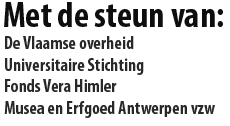A.K.L. THIJS
Recreatie, educatie, devotie en informatie: functies van populaire lectuur (17de – 19de eeuw)
Summary: Entertainment, education, devotion, and information: function of popular reading matter (17th – 19th centuries)
Popular reading matter was the favourite reading material of ordinary people. Wether or not an author or an editor with his publication aimed at ‘popular’ readers, can often be derived from the title, distinguishing linguistic features, the degree of difficulty of the contents, the typeface, the typographical care, and – if known – the selling price. Around 1850 half of our population could not read. Yet illiterates got knowledge of the texts, namely when they were read out to them, recited, sung or retold by ‘cultural intermediaries’. A lot of books (even a lot of devotional literature) was in the first place meant for the middle and the upper classes. Undoubtedly, a great majority of the lower classes had difficulty in reading these texts because of the abstraction of the concepts dealt with.
In this contribution we try to find out what the reading matter for the average reader looked like, and which shifts took place due to changes in the socio-economic, cultural and political field. We also track the authors’ and editors’ intentions (apart from profit seeking) of producing and distributing such reading matter. In the pre-industrial era especially popular books, song leaflets, and almanacs, for the most time having an entertaining function, were printed for a large readership. From the 19the century onwards also periodicals will fulfil a partly entertaining function. Also broadsheets and other texts by means of which the author aimed at an ideological influencing were undoubtedly often mostly appreciated by the readers of a kind of light reading for entertainment.
In the second half of the 19th century an improved spending power, the extension of suffrage, the differentiation of the political spectrum, new pedagogic views, and the increasing level of education, gradually led to the coming into being of a new-fashioned reading matter. So during the Belle Époque old newspapers, popular booklets, almanacs, song leaflets, children’s prints, and other traditional printed matter acquired the status of a curio. Part of the intelligentsia then appropriated this stuff as objects which, in their opinion, would suit well in a folkloristic or archaeological collection.
,
W.L. BRAEKMAN
Bijdrage tot de studie van het raadsel: gedrukte raadsel- boekjes
Summary: Contribution to the Study of the Riddle: printed collections
In the wake of the late Renaat van der Linden book-length study of the Dutch riddle, the present paper surveys the content and scope of six printed riddle booklets and quotes substantially from each. They date from the late sixteenth century to the end of the eighteenth century.
The earliest is schoolmaster Jacob van der Mersch’s popular collection (1593), five years later followed by an anonymous booklet printed at Haarlem. In the seventeenth century there is Jan vander Veens Raadtselen (1653) in two parts, the first of which contains 162 riddles on secular topics. This is followed by Bailliu’s Gulden raedsel-boeck (1664) with some two hundred rhymed religious riddles. The last two collections date from the eighteenth century and are printed at Ghent: the one (1704) is the work of a clergyman, the other (1779) is an almanac with two dozen riddles in rhyme.
,

